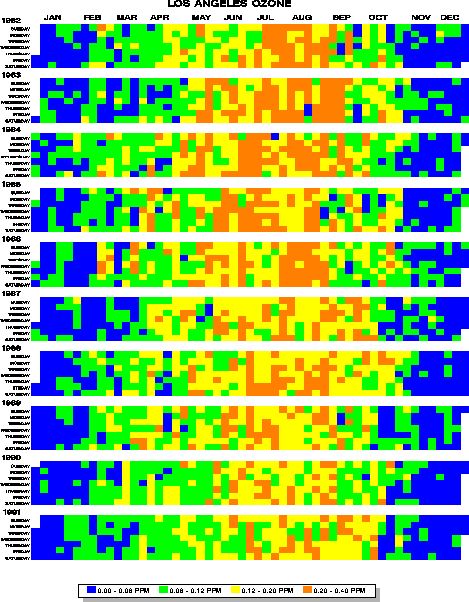Teaching:TUW - UE InfoVis WS 2006/07 - Gruppe 02 - Aufgabe 3 - Prototype
Tile Maps
Summary
Images
Figure 1: a tilemap showing different levels of ocone-concentration in different shades of grey [Mintz et al., 1997].
Figure2: ocone-concentration over several years, color-coded [Friendly, 2006].
Description
Visual Mapping
Introduction
The aim of the visual representation with tile maps is to abstract and simplify seasonal patterns. This makes it easier to recognize patterns or to compare them.
Visualisation / Abstraction
With this visualisation technique the measured data (in our case weather) is represented by "tiles" (squares) which are aranged in 2 dimesions. Every "tile" is representing a certain amount of time. E.g. the images above showing a tile map where every "tile" representing a day which are vertically grouped into weeks. So the chronological sequence is illustrated vertical, from top to bottom, and horizontal, from left to right ... like a 90 degree rotated calendar. The tile map can also be used to display other temporal patterns. For example, displaying diurnal patterns would work much the same way, except each tile represent an hour of the day and would be vertically grouped into days. [Mintz et al., 1997]
The value of the measured data is illustrated by the color or color intensity of the "tiles". For example a light shade indicating low values, darker shades indicating higher values. [Mintz et al., 1997]
Interaction practices
application building
1. Load the data to be visualized into prefuse's data structures, either reading in data from a file, loading data from a database, or through a custom data source. 2. Create a Visualization that maps the loaded data to a visual abstraction. Tables, Graphs, and/or Trees are added to the Visualization and given a unique data group name for later reference. 3. Create a RendererFactory and register it with the Visualization. The factory is responsible for assigning Renderers to VisualItems. 4. Construct a series of data processing Actions that operate on the visual abstraction. These operations can involve just about anything, but common examples include setting the location, color, size, and shape of visual items or animating these properties between different configurations. These Action instances can be grouped into ActionLists for performing various processing tasks. Actions that will be invoked directly are added to the Visualization and given a unique name by which they can be referenced. 5. Initialize one or more interactive Displays for viewing and manipulating visual items. Specify interactive behaviors by adding Controls to the Displays. Search and filtering over data items can be added using dynamic query bindings.
User Interface
Techniques/Functions
- Table Data
- Navigation
* Text
- Zooming
* Alpha-Slider
- Highlighting
- Dynamic Querying
- Selection
- Brushing
- Distortion Techniques
- layout, color, size, and shape encodings, distortion techniques, animation
- query language
* If you are regularly issuing queries (via Predicate filters) to data sets, it might help to index the data columns referenced by the Predicate. This can be done using the index() method of the Table class.
- rendering
* use simple shapes - performance
References
[Friendly, 2006] Michael Friendly. Gallery of Data Visualization. York University: Statistical Consulting Service and Psychology Department. Accessed: 27.11.2006. Gallery of Data Visualization
[Mintz et al., 1997] Mintz, D., Fitz-Simons, T., and Wayland, M.. Tracking Air Quality Trends with SAS/GRAPH. In Proceedings of the 22nd Annual SAS User Group International Conference (SUGI97), pages 807–812, 1997. PDF
[Printezis and Garthwaite, 2002] Tony Printezis, Alex Garthwaite. Visualising The Train Garbage Collector. In Proceedings of the 3rd international symposium on Memory management, Pages: 50 - 63, Berlin, June 20-21, 2002. Publisher: ACM Press. Link on ACM-Portal

